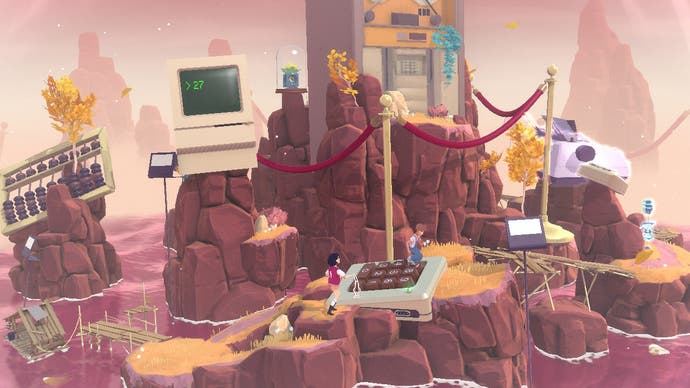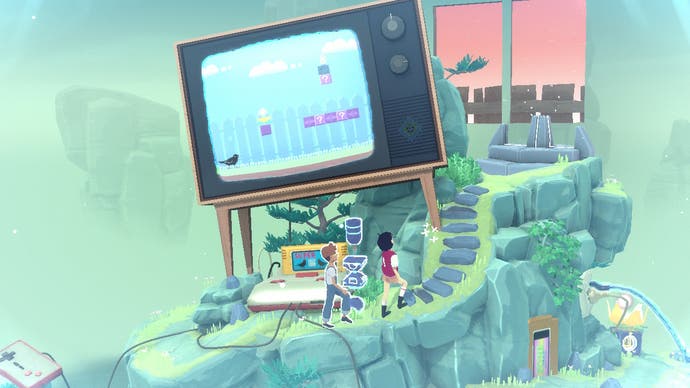The Gardens Between review - a short but vivid voyage into a friendship's past
Thymesplitters.
I've been reading a lot lately about the different ways we imagine time, and one, rather obvious thing I've belatedly realised is that we do not actually perceive time at all, but matter in motion. Time is not a tangible entity whistling past, an arrow through the present's heart, but the shifting sum of the timeframes created by the objects around us: sunrise and fall, the tumbling of popcorn from an upturned bowl, the tickle of drums in a passerby's headphones, the bobbing of cans in a flood. An affectionate, if slightly ephemeral puzzler from Australian indie The Voxel Agents, The Gardens Between revels in this thought. It represents the past as a series of spinning island dioramas, at once unearthly and ordinary, made up of objects you must meddle with to allow time as a whole to play out.
Fancy temporal machinations aside, the game is about the bond between two children, Arina and Frendt, the experiences they have shared and the things they must leave behind. It begins with a long, gloomy silence in a treehouse, a metro train screaming across the cityscape to the rear. Then it whisks you away from all that, away from the harshness of the urban night, to a dreamy archipelago under alien stars - the treehouse now a boat which carries the children from island to island.

Each level is a puzzle consisting of objects from Arina and Frendt's memories - from beachballs and hosepipes to paint buckets and sofa cushion fortresses, the debris of childhood play swollen in hindsight to elephantine proportions. Your goal in each case is to kindle the lantern Arina carries and place it on a plinth at the summit, whereupon the view sweeps upward to reveal the event each island is based on, preserved forever as a constellation.
You don't control the characters themselves. Instead, you tilt the stick to advance or rewind the timeline. Given a clear path your charges will amble to the top of their own accord, the camera circling to keep them in view as they trot along grassy paths and hop between boulders. There's no dialogue, but the animations speak volumes about each protagonist. Arina is bolder, brasher, more inclined to stride ahead. Frendt is a bit of a space cadet, unable to resist tugging at things or wandering off into the crannies while Arina looks on patiently with folded arms.
As the children clamber around each island, they'll encounter obstacles they can't pass - obstacles beyond which time cannot advance. There's the odd wall of purple mist, and bridges of the same substance that disintegrate in the lamp's glow, forcing you to douse it to proceed. There are dusky seedpods that steal away the lamplight as though sucking the full stop off the end of a sentence. In each case, you'll need to wind back the gears and look for the objects you can change, opportunities to step just a little outside the progress of the memory and tinker with its clockwork.

The most frequent of these variables are the strangely animate blocks that skip across the terrain according to their own, mysterious schedules, sometimes independently of Arina and Frendt's timeline. Arina can mount her lantern on a block to launch it into the vicinity of an otherwise unreachable light source, scooping up the lantern when next that block crosses your path. There are also bells Frendt can ring to alter something without advancing time, dragging a key prop back and forth like an audio editor dropping effects into a composition.
If they function well enough as puzzle props, the blocks are a little dissatisfying for their (as far as I can see) lack of a personal connection to the characters. More diverting are the conundrums that involve tweaks to the objects each memory is associated with - fat keypads you can trample over to bash something out on a nearby screen, dinosaur skeletons from museum exhibits that collapse and reassemble, altering the lay of the land, and telescopes that swivel on their tripods, carrying the sky along with them.
There are moments of real delight as you work out exactly what you can mess with, pursuing the surprisingly elaborate chains of cause and effect that stretch behind what is ostensibly just a cutscene you can pause and rewind. In a predictable but bearable show of quintessentially "indie" nostalgia, some of the best setups involve pieces of ancient gaming hardware, canted across the path like ritual obelisks. I won't spoil it, but the pick of the litter involves working out how to manipulate something non-linear while reckoning with a control scheme that only lets characters travel in two directions.

It's not all candy and slumber parties. If the goal is to tell a story about people, The Garden Between's strategy of telling that story through clusters of objects risks reducing those people to the things they cherish. The ending does a reasonable job, however, of making the point that to treasure one's possessions is to be possessed by them. It reveals the voyage between gardens for a stately act of letting go.
The characterisation - and I should probably remind you at this point that I am a miserable old crank - is perhaps a little too sweet-natured for its own good. In my experience, at least, best friendships are rarely this untroubled; they are also about arguments and misunderstandings, estrangements that slowly evaporate, none of which find its way into The Gardens Between. There are gloomier moments, in fairness, and there is nothing wrong in itself with preferring the sunshine to the rain, but I do think there's a missed opportunity here. With their stops and starts, their cracking and reassembling of overlapping timelines, the puzzles might have explored moments of discord between the characters - moments when they were, if not at odds, at least out of synch. Without that element of friction, the game can feel a little twee.
The puzzles, moreover, lose their novelty towards the finale, and none of them will preoccupy you for long. It's always nice when games don't outstay their welcome in this, the age of Endless Content, but some of the more inspired individual concepts here are dispensed with far too quickly. Still, The Gardens Between is lovely for as long as it lasts. If time is a composite of the time signatures objects weave about them, this one is valuable for how it slows everything down without putting you to sleep. I found it engrossing but also soothing, like the waltz of leaves on a windy street.

